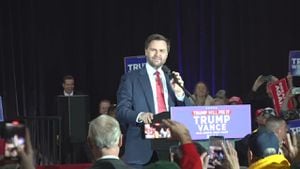In a significant pre-election push, JD Vance, the Republican vice presidential nominee, participated in an invigorating rally in Derry, New Hampshire, drawing thousands of supporters as the crucial election day approached. The event took place at the New England Sports Center on a Sunday night, where enthusiastic voters gathered both inside and outside the venue, even lining the streets to catch a glimpse of Vance as he arrived in a motorcade accompanied by Donald Trump Jr. Prior to the New Hampshire stop, Vance had campaigned in North Carolina and Pennsylvania, highlighting the importance of rallying support in key swing states. Meanwhile, his running mate, former President Donald Trump, conducted his own rally in North Carolina, emphasizing the need for a decisive victory where poll results would be finalized by the early hours of Tuesday.
The atmosphere at the rally was charged with anticipation, as Vance delivered messages aimed at energizing the party base while appealing to undecided voters. With the election drawing near, Trump’s remarks echoed the urgency of the moment, reminding attendees that this marks his third consecutive bid for the presidency as the Republican nominee, thus reinforcing the stakes involved in the upcoming vote. The dual campaigns reflect a well-coordinated effort by the Republican ticket to secure necessary votes, especially in regions like New Hampshire, which can significantly influence the overall election outcome.
On the Democratic side, Vice President Kamala Harris mounted her final campaign strategies in East Lansing, Michigan, where she addressed supporters and projected a message of unity and forward momentum. Harris articulated her vision of a nation seeking to overcome division and hatred, a direct appeal to voters looking for a positive change in the political landscape. This rally underscored the Democrats’ focus on themes of inclusivity and healing, contrasting sharply with the Republican narrative. As a key battleground state, Michigan remains vital for the Democratic ticket’s winning prospects, making Harris’s rally an essential part of their closing strategy.
Adding to the Democratic efforts, Minnesota Governor Tim Walz spearheaded a rally in Georgia, another major battleground, reinforcing the party’s intent to win over crucial constituents just days before the election. Walz’s assertion that they haven’t secured victory yet, despite confidence in their coalition, illustrates the awareness of both parties regarding the unpredictable nature of political contests. With the stakes this high, Democratic leaders are fully engaging with voters to ensure their turnout on election day, recognizing that every single vote could potentially sway the results in their favor.
As the campaigns ramp up, attention also turns to logistics, with polling sites in states such as Massachusetts and New Hampshire set to close as early as 8 p.m. ET on election night. The timing of the votes, combined with candidates’ final pushes, emphasize the strategic planning that both parties invest in the lead-up to polling day. The Republican campaign is eager to harness enthusiasm and momentum generated during one of the last rallies, while Democrats strive to solidify voter support through impassioned speeches and promises of a progressive agenda.
Overall, the frenzied activity leading up to the elections showcases the intense competition between the Republican and Democratic tickets, both attempting to galvanize their bases while reaching out to undecided voters. The blend of personal appeals, promises of change, and a clear understanding of the pivotal nature of key states reflect the high stakes of this election. As both parties prepare for the final hours before voters go to the polls, the underlying enthusiasm and strategic messaging are evident, setting the stage for what promises to be a contentious and closely watched election result.

